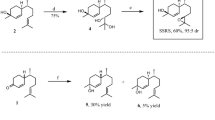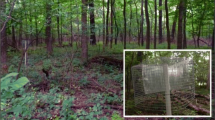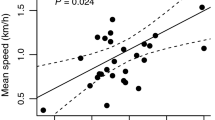Abstract
Anisomorpha buprestoides, a walkingstick common in the southeastern United States, sprays chemicals that irritate and repel threatening insects, birds, or mammals. The active chemical in this substance was initially identified as a monoterpene dialdehyde. This compound can be present in several stereoisomeric forms, and subsequent studies have revealed that A. buprestoides produces at least three diastereomers: anisomorphal, dolichodial, and peruphasmal. However, no inquiry has been made to date into the geographical or developmental dependence of this variation. We report here that different populations of adult A. buprestoides spray either anisomorphal, or peruphasmal, or a mixture of the two stereoisomers. Additionally, offspring of a peruphasmal-producing population produced a variable mixture of anisomorphal and dolichodial but switched to peruphasmal upon reaching sexual maturity. This appears to be the first report of a developmentally regulated change in walkingstick insect chemical defense. Our results suggest a more complex role of these substances in the overall chemical ecology of walkingstick insects.




Similar content being viewed by others
References
Bedford, G. O. 1978. Biology and ecology of the phasmatodea. Annu. Rev. Entomol. 23:125–149.
Blatt, S. E., Borden, J. H., Pierce, H. D., Gries, R., and Gries, G. 1998. Alarm pheromone system of the western conifer seed bug, Leptoglossus occidentalis. J. Chem. Ecol. 24:1013–1031.
Blum, M. S. 1996. Semiochemical parsimony in the arthropoda. Annu. Rev. Entomol. 41:353–374.
Bouchard, P., Hsiung, C. C., and Yaylayan, V. A. 1997. Chemical analysis of defense secretions of sipyloidea sipylus and their potential use as repellents against rats. J. Chem. Ecol. 23:2049–2057.
Brey, W. W., Edison, A. S., Nast, R. E., Rocca, J. R., Saha, S., and Withers, R. S. 2006. Design, construction, and validation of a 1-mm triple-resonance high-temperature-superconducting probe for nmr. J Magn. Reson. 179:290–3.
Cavill, G. W. K., and Hinterberger, H. 1961. Chemistry of ants. 5. Structure and reactions of dolichodial. Aust. J. Chem. 14:143–149.
Cavill, G. W. K., Houghton, E., McDonald, F. J., and Williams, P. J. 1976. Isolation and characterization of dolichodial and related compounds from argentine ant, iridomyrmex-humilis. Insect Biochem. 6:483–490.
Cavill, G. W. K., and Whitfield, F. B. 1964. Insect venoms, attractants & repellents .6. Synthesis of dolichodials. Aust. J. Chem. 17:1260–1269.
Chow, Y. S., and Lin, Y. M. 1986. Actinidine, a defensive secretion of stick insect, megacrania alpheus westwood (orthoptera, phasmatidae). J. Entomol. Sci. 21:97–101.
Dossey, A. T., Walse, S. S., Conle, O. V., and Edison, A. S. 2007. Parectadial, a monoterpenoid from the defensive spray of parectatosoma mocquerysi. J. Nat. Prod. 70(8):1335–1338.
Dossey, A. T., Walse, S. S., Rocca, J. R., and Edison, A. S. 2006. Single insect nmr: a new tool to probe chemical biodiversity. ACS Chem. Biol. 1:511–4.
Eisner, T., Morgan, R. C., Attygalle, A. B., Smedley, S. R., Herath, K. B., and Meinwald, J. 1997. Defensive production of quinoline by a phasmid insect (oreophoetes peruana). J. Exp. Biol. 200:2493–500.
Eisner, T. 1965. Defensive spray of a phasmid insect. Sci. 148:966–968.
Eisner, T., Eisner, M., and Siegler, M. 2005. Secret weapons: defenses of insects, spiders, scorpions, and other many-legged creatures. Belknap Press of Harvard University Press, Cambridge, Massachusetts.
Farine, J. P., Everaerts, C., Lequere, J. L., Semon, E., Henry, R., and Brossut, R. 1997. The defensive secretion of eurycotis floridana (dictyoptera, blattidae, polyzosteriinae): Chemical identification and evidence of an alarm function. Insect Biochem. Mol. Biol. 27:577–586.
Hetrick, L. 1949. Field notes on a color variant of the two-striped walkingstick, Anisomorpha buprestoides, (stoll). Fla. Entomol. 32:74–77.
Ho, H. Y., and Chow, Y. S. 1993. Chemical-identification of defensive secretion of stick insect, megacrania tsudai shiraki. J. Chem. Ecol. 19:39–46.
Meinwald, J., Chadha, M. S., Hurst, J. J., and Eisner, T. 1962. Defense mechanisms of arthropods .9. Anisomorphal, the secretion of a phasmid insect. Tett. Letters. 29–33.
Pagnoni, U. M., Pinetti, A., Trave, R., and Garanti, L. 1976. Monoterpenes of teucrium-marum. Aus. J. Chem. 29:1375–1381.
Roisin, Y., Everaerts, C., Pasteels, J. M., and Bonnard, O. 1990. Castedependent reactions to soldier defensive secretion and chiral alarm recruitment pheromone in nasutitermes-princeps. J. Chem. Ecol. 16:2865–2875.
Schmeda-Hirschmann, G. 2006. 4-methyl-1-hepten-3-one, the defensive compound from agathemera elegans (philippi) (phasmatidae) insecta. Zeitschrift Fur Natur. C - J. Biosci. 61:592–594.
Schneider, C. O. 1934. Las emanaciones del chinchemayo paradoxomorpha crassa. Rev. Chil. Hist. Nat. 38:44–46.
Smith, R. M., Brophy, J. J., Cavill, G. W. K., and Davies, N. W. 1979. Iridodials and nepetalactone in the defensive secretion of the coconut stick insects, graeffea crouani. J. Chem. Ecol. 5:727–735.
Thomas, M. C. 2001. The twostriped walkingstick, Anisomorpha buprestoides (stoll), (phasmatodea: Pseudophasmatidae). Fla. Dept. Agri. & Consumer Svcs. Division of Plant Industry. Entomol. Circ. 408:1–4.
Tilgner, E. H. 2002. Systematics of phasmida. Ph.D. Dissertation. University of Georgia, Athens, GA.
Acknowledgments
We thank Drs. W. Brey (NHMFL), R. Withers (Varian), R. Nast (Varian), and Bruker for the 1-mm HTS NMR probe. J. Rocca (AMRIS) provided help with NMR, and O. Conle (Bolsterlang, Germany) provided advice on walkingsticks. Dr. P. Teal (USDA) provided support and laboratory resources. Dr. Omjoy Ganesh (UF) provided technical help with making ternary diagrams. Drs. P. Sternberg (Caltech) and S. Benner (The Westheimer Institute of Science and Technology) provided helpful comments on the text. Funding was from the Human Frontiers Science Program and the NSF funded National High Magnetic Field Laboratory. The authors declare no competing financial interests.
Author information
Authors and Affiliations
Corresponding author
Electronic supplementary material
Below is the link to the electronic supplementary material.
Supplementary Table 1
Dolichodial diastereomer composition of defensive spray field milkings from adult Anisomorpha buprestoides at various locations in the state of Florida, USA. Percent compositions are rounded to the nearest 1% unless determined to be <0.5% in which case they are indicated as such. Data were quantified using integrals of GC-FID traces, except for the GNV population which was measured by NMR. The gender of each individual is also provided (DOC 124 KB).
Supplementary Table 2
Dolichodial diastereomer composition of defensive spray milkings from A. buprestoides at various life stages. Sixteen offspring (ten males, three females, and three undetermined) of the Gainesville Airport (GNV) population were chosen for this study. Percent compositions are rounded to the nearest 1% unless determined to be <0.5% in which case they are indicated as such. “0” means that particular isomer was not observed. “Dead” means that that animal died at that stage in the study. “N/A” means that the sample was unavailable for analysis, possibly lost. Data were quantified using integrals of GC-MS traces. Gender of each individual is also provided. Gender was not determined for the three animals that died early (DOC 172 KB).
Supplementary Figure 1
Representative GC-MS chromatograms of individual Anisomorpha buprestoides on different days during the developmental portion of this study. Shown here are data from six individuals (five males and one female). The insects were raised from hatchling to adult in individual containers. Individual secretions were collected from hatchlings and at subsequent intervals ranging from 1 to 5 weeks, and secretions were analyzed by GC-MS. The elution times of the three A. buprestoides isomers, peruphasmal (P), dolichodial (D), and anisomorphal (A) are indicated in red. Missing or baseline data indicate difficulties obtaining that particular spray (DOC 173 KB).
Supplementary Video 1
Video showing the feeding of 13C6 glucose to a wild male A. buprestoides from the GNV population. A 1-ml syringe was used to place droplets of 400 mM 13C6 glucose in water on the mouthparts of the insect until the insect stopped drinking it (usually after drinking about 50 μl). This was done every other day for about a month, feeding the insect variegated privet on days where 13C6 glucose was not given to provide the insect with additional essential nutrients (DOC 173 KB).
Rights and permissions
About this article
Cite this article
Dossey, A.T., Walse, S.S. & Edison, A.S. Developmental and Geographical Variation in the Chemical Defense of the Walkingstick Insect Anisomorpha buprestoides . J Chem Ecol 34, 584–590 (2008). https://doi.org/10.1007/s10886-008-9457-8
Received:
Revised:
Accepted:
Published:
Issue Date:
DOI: https://doi.org/10.1007/s10886-008-9457-8




